Interfacial Stresses of Thermal Barrier Coating with Film Cooling Holes Induced by CMAS Infiltration
Abstract
:1. Introduction
2. Modeling Methodology
2.1. CFD Modeling of the Fluid Domain
2.2. FE Modeling of the Solid Domain
2.3. Material Characteristic
2.4. Volume Expansion by Phase Transformation
3. Results
3.1. Influence of Film Cooling Holes
3.2. Influence of CMAS Infiltration
3.3. Stress Field with CMAS Infiltration
4. Conclusions
Author Contributions
Funding
Institutional Review Board Statement
Informed Consent Statement
Data Availability Statement
Conflicts of Interest
References
- Clarke, D.R.; Oechsner, M.; Padture, N.P. Thermal-barrier coatings for more efficient gas-turbine engines. MRS Bull. 2012, 37, 891–898. [Google Scholar] [CrossRef] [Green Version]
- Padture, N.P.; Gell, M.; Jordan, E.H. Thermal barrier coatings for gas-turbine engine applications. Science 2002, 296, 280–284. [Google Scholar] [CrossRef] [PubMed]
- Kistenmacher, D.A.; Todd Davidson, F.; Bogard, D.G. Realistic trench film cooling with a thermal barrier coating and deposition. J. Turbomach. 2014, 136, 091002. [Google Scholar] [CrossRef]
- Zhao, L.; Wang, T. An experimental study of mist/air film cooling on a flat plate with application to gas turbine airfoils—Part I: Heat transfer. J. Turbomach. 2014, 136, 071006. [Google Scholar] [CrossRef]
- Nieto, A.; Walock, M.; Ghoshal, A.; Zhu, D.; Gamble, W.; Barnett, B.; Murugan, M.; Pepi, M.; Rowe, C.; Pegg, R. Layered, composite, and doped thermal barrier coatings exposed to sand laden flows within a gas turbine engine: Microstructural evolution, mechanical properties, and CMAS deposition. Surf. Coat. Technol. 2018, 349, 1107–1116. [Google Scholar] [CrossRef]
- Keyvani, A.; Saremi, M.; Sohi, M.H.; Valefi, Z.; Yeganeh, M.; Kobayashi, A. Microstructural stability of nanostructured YSZ–alumina composite TBC compared to conventional YSZ coatings by means of oxidation and hot corrosion tests. J. Alloy. Compd. 2014, 600, 151–158. [Google Scholar] [CrossRef]
- Bansal, N.P.; Choi, S.R. Properties of Desert Sand and CMAS Glass; National Aeronautics and Space Administration, Glenn Research Center: Cleveland, OH, USA, 2014.
- Krämer, S.; Yang, J.; Levi, C.G.; Johnson, C.A. Thermochemical interaction of thermal barrier coatings with molten CaO-MgO-Al2O3-SiO2(CMAS) deposits. J. Am. Ceram. Soc. 2006, 89, 3167–3175. [Google Scholar] [CrossRef]
- Cai, Z.; Zhang, Z.; Liu, Y.; Zhao, X.; Wang, W. Numerical study on effect of non-uniform CMAS penetration on TGO growth and interface stress behavior of APS TBCs. Chin. J. Mech. Eng. 2021, 34, 1–16. [Google Scholar] [CrossRef]
- Fang, H.; Wang, W.; Huang, J.; Ye, D. Investigation of CMAS resistance of sacrificial plasma-sprayed mullite-YSZ protective layer on 8YSZ thermal barrier coating. Corros. Sci. 2020, 173, 108764. [Google Scholar] [CrossRef]
- Shan, X.; Zou, Z.; Gu, L.; Yang, L.; Guo, F.; Zhao, X.; Xiao, P. Buckling failure in air-plasma sprayed thermal barrier coatings induced by molten silicate attack. Scr. Mater. 2016, 113, 71–74. [Google Scholar] [CrossRef]
- Ranjbar-Far, M.; Absi, J.; Mariaux, G.; Dubois, F. Simulation of the effect of material properties and interface roughness on the stress distribution in thermal barrier coatings using finite element method. Mater. Des. 2010, 31, 772–781. [Google Scholar] [CrossRef]
- Evans, A.G.; Hutchinson, J.W. The mechanics of coating delamination in thermal gradients. Surf. Coat. Technol. 2007, 201, 7905–7916. [Google Scholar] [CrossRef]
- Wu, J.; Guo, H.-B.; Gao, Y.-Z.; Gong, S.-K. Microstructure and thermo-physical properties of yttria stabilized zirconia coatings with CMAS deposits. J. Eur. Ceram. Soc. 2011, 31, 1881–1888. [Google Scholar] [CrossRef]
- Kim, K.M.; Shin, S.; Lee, D.H.; Cho, H.H. Influence of material properties on temperature and thermal stress of thermal barrier coating near a normal cooling hole. Int. J. Heat Mass Transf. 2011, 54, 5192–5199. [Google Scholar] [CrossRef]
- Jiang, J.; Cai, Z.; Wang, W.; Liu, Y. Finite element analysis of thermal-mechanical behavior in the thermal barrier coatings with cooling hole structure. In Proceedings of the Turbo Expo: Power for Land, Sea, and Air, Charlotte, NC, USA, 26–30 June 2017; p. V006T024A011. [Google Scholar]
- Jiang, J.; Jiang, L.; Cai, Z.; Wang, W.; Zhao, X.; Liu, Y.; Cao, Z. Numerical stress analysis of the TBC-film cooling system under operating conditions considering the effects of thermal gradient and TGO growth. Surf. Coat. Technol. 2019, 357, 433–444. [Google Scholar] [CrossRef]
- Jiang, J.; Ma, X.; Wang, B. Stress analysis of the thermal barrier coating system near a cooling hole considering the free-edge effect. Ceram. Int. 2020, 46, 331–342. [Google Scholar] [CrossRef]
- Meng, Z.; Liu, Y.; Li, Y.; Zhang, Y. An analytical model for predicting residual stress in TBC-film cooling system considering non-uniform temperature field. J. Appl. Phys. 2021, 129, 135301. [Google Scholar] [CrossRef]
- Hsueh, C.H.; Luttrell, C.R.; Lee, S.; Wu, T.C.; Lin, H.Y. Interfacial peeling moments and shear forces at free edges of multilayers subjected to thermal stresses. J. Am. Ceram. Soc. 2006, 89, 1632–1638. [Google Scholar] [CrossRef]
- Choi, S.R.; Hutchinson, J.W.; Evans, A. Delamination of multilayer thermal barrier coatings. Mech. Mater. 1999, 31, 431–447. [Google Scholar] [CrossRef]
- Zhang, T.; Pu, J.; Zhou, W.-L.; Wang, J.-H.; Wu, W.-L.; Chen, Y. Effect of transverse trench on film cooling performances of typical fan-shaped film-holes at concave and convex walls. Int. J. Heat Mass Transf. 2021, 175, 121384. [Google Scholar] [CrossRef]
- Long, Y.; Chen, X.; Wang, Y.; Weng, Y. Conjugate flow and heat transfer analysis between segmented thermal barrier coatings and cooling film. Int. J. Therm. Sci. 2021, 167, 107003. [Google Scholar] [CrossRef]
- Tian, K.; Tang, Z.; Wang, J.; Vujanović, M.; Zeng, M.; Wang, Q. Numerical investigations of film cooling and particle impact on the blade leading edge. Energies 2021, 14, 1102. [Google Scholar] [CrossRef]
- Song, Y.J.; Park, S.H.; Kang, Y.J.; Kwak, J.S. Effects of trench configuration on the film cooling effectiveness of a fan-shaped hole. Int. J. Heat Mass Transf. 2021, 178, 121655. [Google Scholar] [CrossRef]
- Dai, H.; Zhang, J.; Ren, Y.; Liu, N.; Lin, J. Effect of cooling hole configurations on combustion and heat transfer in an aero-engine combustor. Appl. Therm. Eng. 2021, 182, 115664. [Google Scholar] [CrossRef]
- Wang, T.; Li, X. Mist film cooling simulation at gas turbine operating conditions. Int. J. Heat Mass Transf. 2008, 51, 5305–5317. [Google Scholar] [CrossRef]
- Li, X.; Wang, T. Effects of various modeling schemes on mist film cooling simulation. J. Heat Transf. 2007, 129, 472–482. [Google Scholar] [CrossRef] [Green Version]
- Mostofizadeh, A.R.; Adami, M.; Shahdad, M.H. Multi-objective optimization of 3D film cooling configuration with thermal barrier coating in a high pressure vane based on CFD-ANN-GA loop. J. Braz. Soc. Mech. Sci. Eng. 2018, 40, 1–15. [Google Scholar] [CrossRef]
- Alfonsi, G. Reynolds-averaged Navier–Stokes equations for turbulence modeling. Appl. Mech. Rev. 2009, 62, 040802. [Google Scholar] [CrossRef]
- Menter, F.R. Two-equation eddy-viscosity turbulence models for engineering applications. AIAA J. 1994, 32, 1598–1605. [Google Scholar] [CrossRef] [Green Version]
- Menter, F.; Rumsey, C. Assessment of two-equation turbulence models for transonic flows. In Proceedings of the Fluid Dynamics Conference, Colorado Springs, CO, USA, 20–23 June 1994; p. 2343. [Google Scholar]
- Białas, M. Finite element analysis of stress distribution in thermal barrier coatings. Surf. Coat. Technol. 2008, 202, 6002–6010. [Google Scholar] [CrossRef]
- Ranjbar-Far, M.; Absi, J.; Shahidi, S.; Mariaux, G. Impact of the non-homogenous temperature distribution and the coatings process modeling on the thermal barrier coatings system. Mater. Des. 2011, 32, 728–735. [Google Scholar] [CrossRef]
- Sfar, K.; Aktaa, J.; Munz, D. Numerical investigation of residual stress fields and crack behavior in TBC systems. Mater. Sci. Eng. A 2002, 333, 351–360. [Google Scholar] [CrossRef]
- Jackson, R.W.; Zaleski, E.M.; Poerschke, D.L.; Hazel, B.T.; Begley, M.R.; Levi, C.G. Interaction of molten silicates with thermal barrier coatings under temperature gradients. Acta Mater. 2015, 89, 396–407. [Google Scholar] [CrossRef]
- Levi, C.G.; Hutchinson, J.W.; Vidal-Sétif, M.-H.; Johnson, C.A. Environmental degradation of thermal-barrier coatings by molten deposits. MRS Bull. 2012, 37, 932–941. [Google Scholar] [CrossRef] [Green Version]
- Kakuda, T.R.; Levi, C.G.; Bennett, T.D. The thermal behavior of CMAS-infiltrated thermal barrier coatings. Surf. Coat. Technol. 2015, 272, 350–356. [Google Scholar] [CrossRef]
- Tseng, S.; Chao, C.; Li, D.; Fan, X. Experimental and simulation analysis of the evolution of residual stress due to expansion via CMAS infiltration in thermal barrier coatings. Coatings 2021, 11, 1148. [Google Scholar] [CrossRef]
- Garces, H.F.; Senturk, B.S.; Padture, N.P. In situ Raman spectroscopy studies of high-temperature degradation of thermal barrier coatings by molten silicate deposits. Scr. Mater. 2014, 76, 29–32. [Google Scholar] [CrossRef]
- Yashima, M.; Kakihana, M.; Yoshimura, M. Metastable-stable phase diagrams in the zirconia-containing systems utilized in solid-oxide fuel cell application. Solid State Ion. 1996, 86, 1131–1149. [Google Scholar] [CrossRef]
- Evans, A.G.; Mumm, D.; Hutchinson, J.; Meier, G.; Pettit, F. Mechanisms controlling the durability of thermal barrier coatings. Prog. Mater. Sci. 2001, 46, 505–553. [Google Scholar] [CrossRef]
- Cai, Z.; Hong, H.; Peng, D.; Zhao, X.; Wang, W.; Liu, Y.; Cao, Z. A numerical study of the influence of interface morphology on the stress behavior in thermal barrier coatings near an inclined film-cooling hole. Ceram. Int. 2020, 46, 18142–18150. [Google Scholar] [CrossRef]
- Pujol, G.; Ansart, F.; Bonino, J.-P.; Malié, A.; Hamadi, S. Step-by-step investigation of degradation mechanisms induced by CMAS attack on YSZ materials for TBC applications. Surf. Coat. Technol. 2013, 237, 71–78. [Google Scholar] [CrossRef] [Green Version]
- Ma, G.; He, P.; Chen, S.; Kang, J.; Wang, H.; Liu, M.; Zhao, Q.; Li, G. Physicochemical Properties of Yttria-Stabilized-Zirconia In-Flight Particles during Supersonic Atmospheric Plasma Spray. Coatings 2019, 9, 431. [Google Scholar] [CrossRef] [Green Version]
- Tseng, S.; Chao, C.; Zhang, W.; Fan, X. Microcrack propagation induced by dynamic infiltration of calcium-magnesium-alumino-silicate in columnar structures for thermal barrier coatings. J. Chin. Inst. Eng. 2020, 44, 11–21. [Google Scholar] [CrossRef]
- Zhang, G.; Fan, X.; Xu, R.; Su, L.; Wang, T.J. Transient thermal stress due to the penetration of calcium-magnesium-alumino-silicate in EB-PVD thermal barrier coating system. Ceram. Int. 2018, 44, 12655–12663. [Google Scholar] [CrossRef]
- Tseng, S.C.; Chao, C.K.; Chen, F.M.; Chiu, W.C. Interfacial stresses of a coated polygonal hole subject to a point heat source. J. Therm. Stresses 2020, 43, 1487–1512. [Google Scholar] [CrossRef]
- Tseng, S.C.; Chao, C.K.; Chen, F.M. Interfacial stresses of a coated square hole induced by a remote uniform heat flow. Int. J. Appl. Mech. 2020, 12, 12. [Google Scholar] [CrossRef]

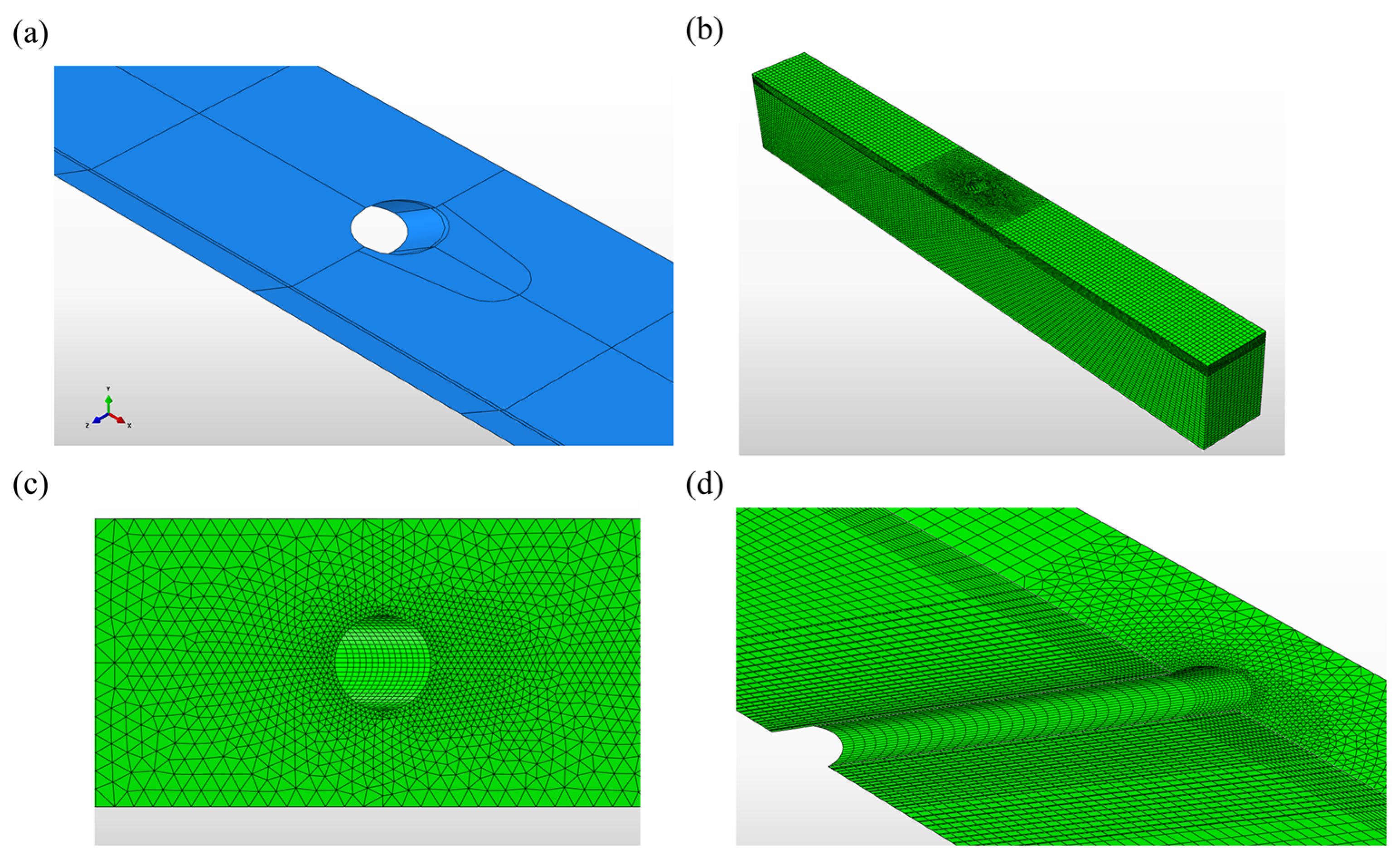


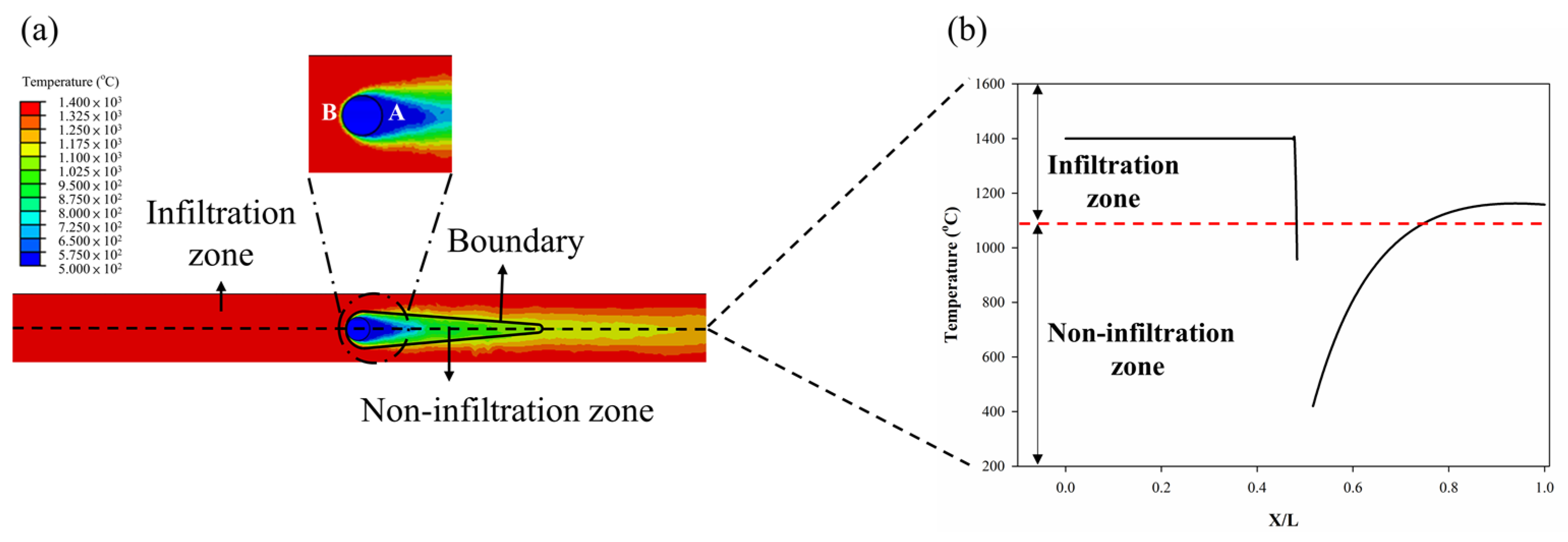
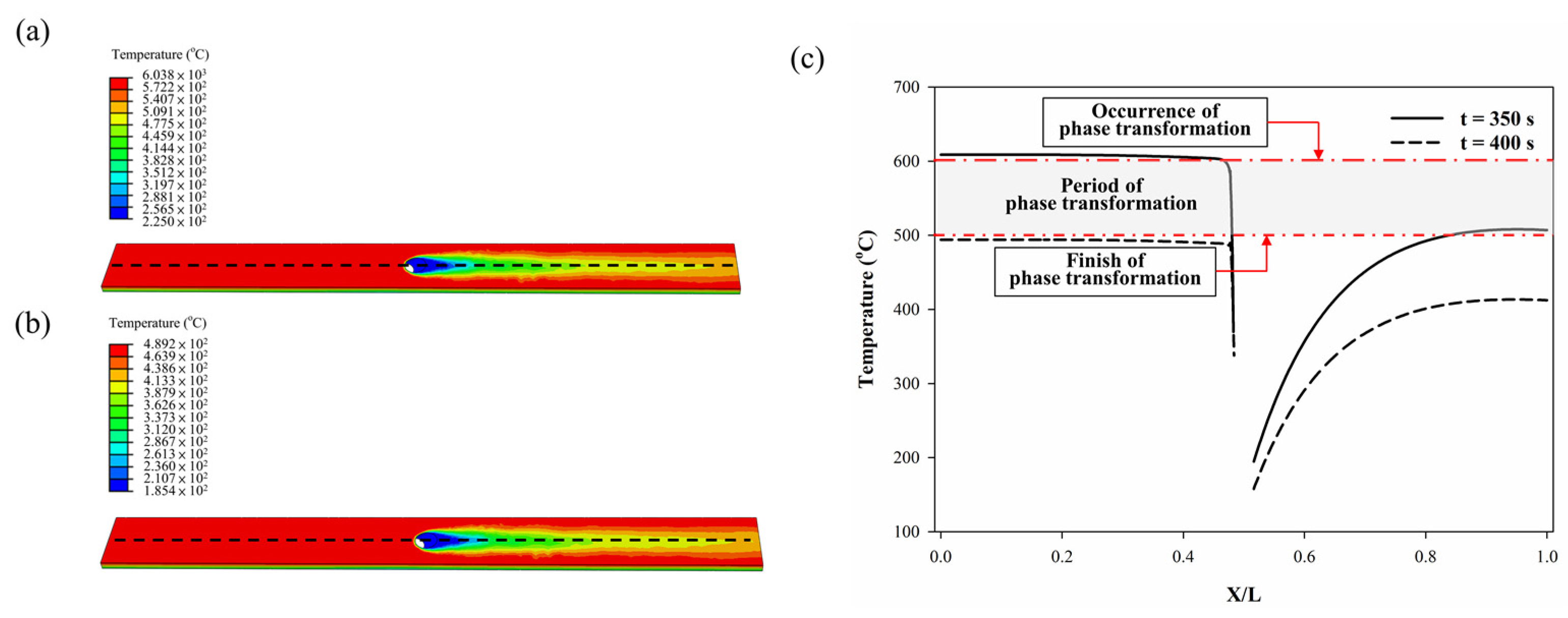

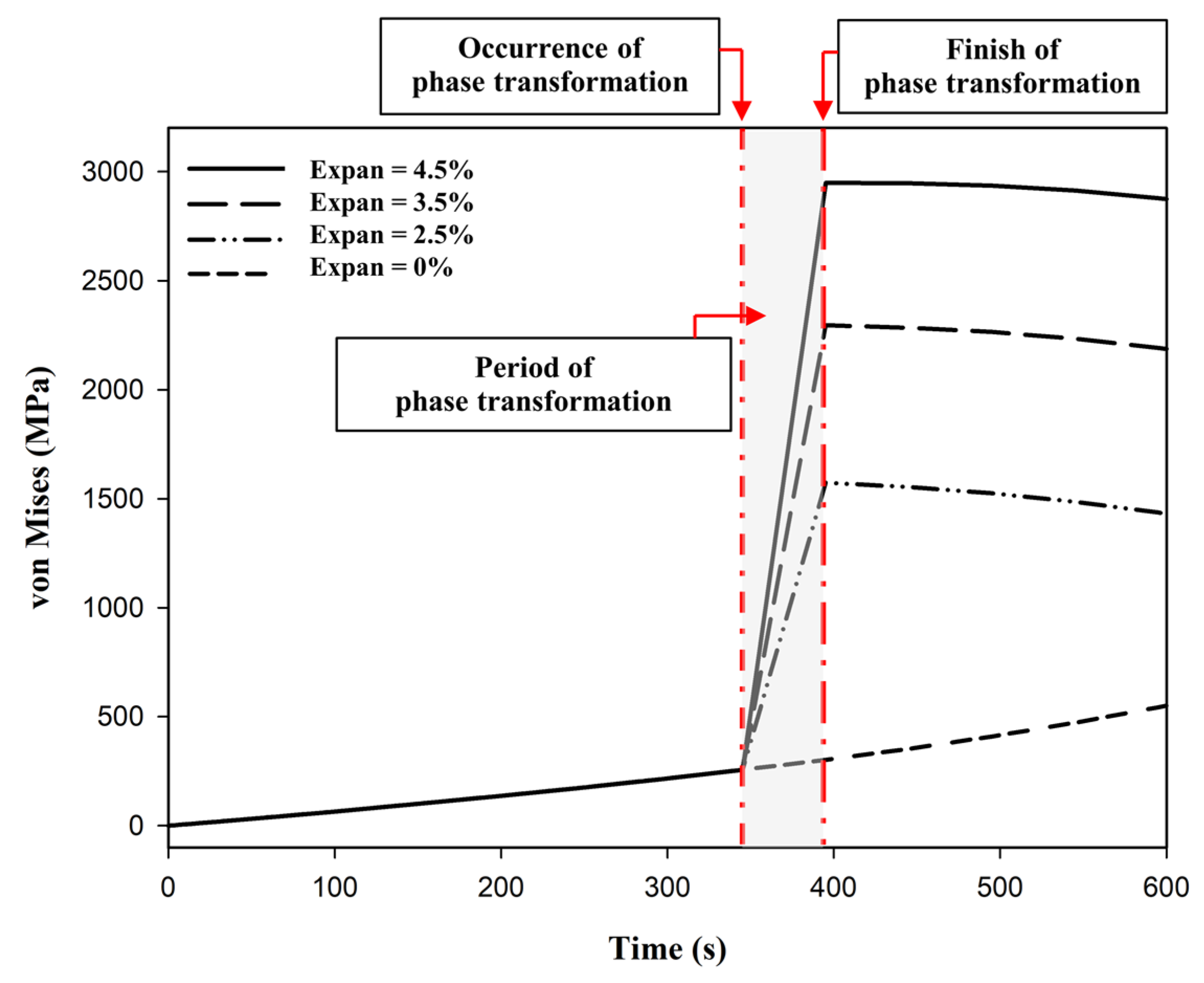
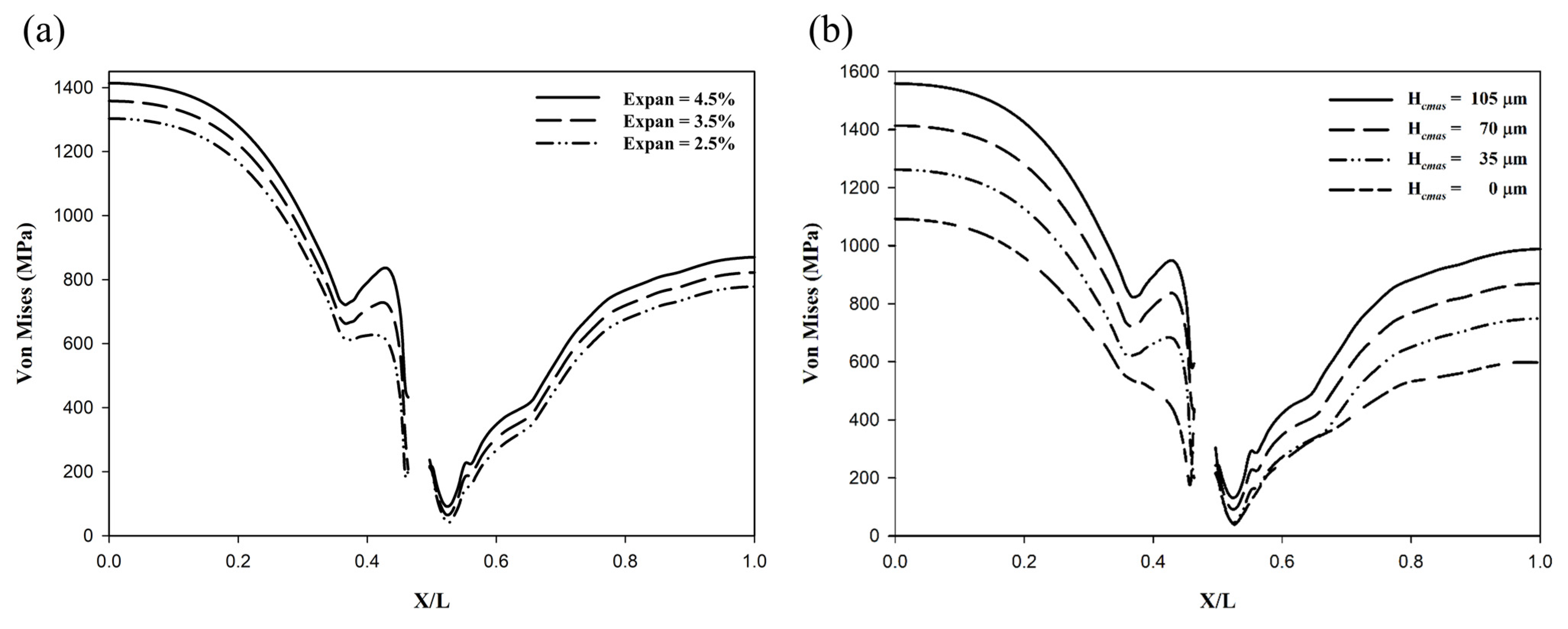
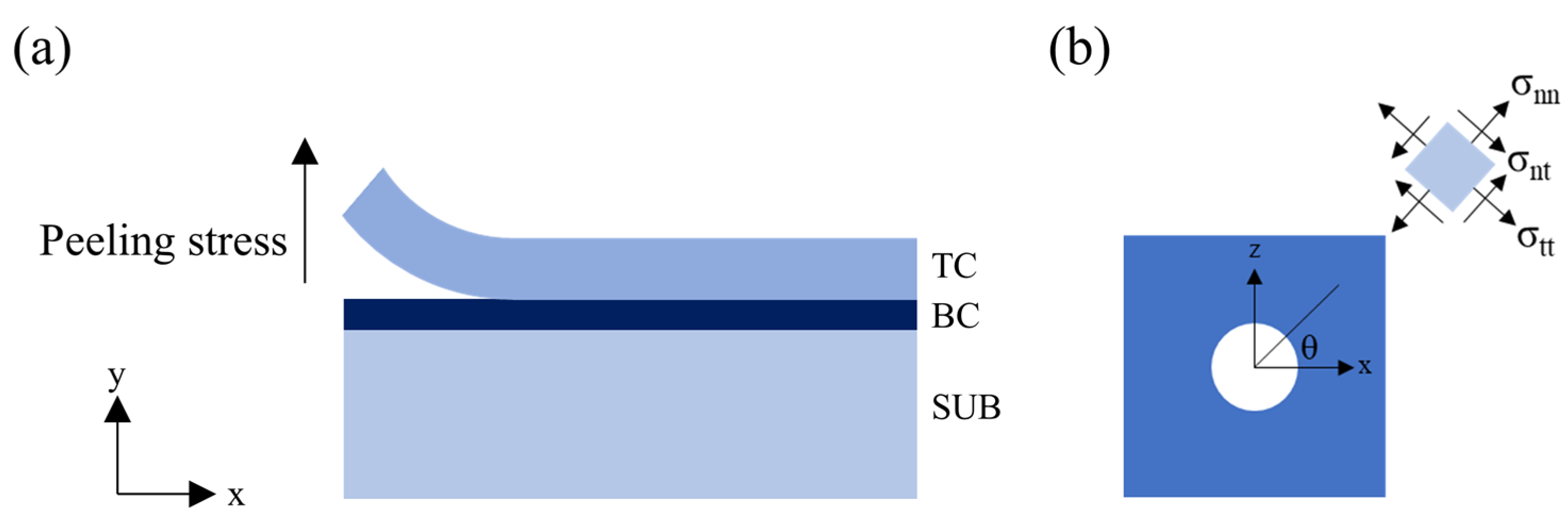


| Material | T (°C) | E (GPa) | v | k (W/mK) | α × 10−6 (°C−1) |
|---|---|---|---|---|---|
| TC layer | 25 1000 | 17.5 12.4 | 0.2 | 1.05 1.88 | 9.68 11 |
| Bond coat | 25 400 800 1000 | 220 200 164 120 | 0.3 | 4.3 6.4 10.2 11.1 | 10.3 12.7 14.1 20.4 |
| Substrate | 100 300 500 700 900 | 209 199 185 167 145 | 0.38 0.38 0.39 0.39 0.4 | 11.4 14.9 18.3 21.8 25.2 | 11.1 13.3 14.0 14.6 15.4 |
Publisher’s Note: MDPI stays neutral with regard to jurisdictional claims in published maps and institutional affiliations. |
© 2022 by the authors. Licensee MDPI, Basel, Switzerland. This article is an open access article distributed under the terms and conditions of the Creative Commons Attribution (CC BY) license (https://creativecommons.org/licenses/by/4.0/).
Share and Cite
Chiu, C.; Tseng, S.; Chao, C.; Fan, X.; Cheng, W. Interfacial Stresses of Thermal Barrier Coating with Film Cooling Holes Induced by CMAS Infiltration. Coatings 2022, 12, 326. https://doi.org/10.3390/coatings12030326
Chiu C, Tseng S, Chao C, Fan X, Cheng W. Interfacial Stresses of Thermal Barrier Coating with Film Cooling Holes Induced by CMAS Infiltration. Coatings. 2022; 12(3):326. https://doi.org/10.3390/coatings12030326
Chicago/Turabian StyleChiu, Chenchun, Shaochen Tseng, Chingkong Chao, Xueling Fan, and Weihung Cheng. 2022. "Interfacial Stresses of Thermal Barrier Coating with Film Cooling Holes Induced by CMAS Infiltration" Coatings 12, no. 3: 326. https://doi.org/10.3390/coatings12030326
APA StyleChiu, C., Tseng, S., Chao, C., Fan, X., & Cheng, W. (2022). Interfacial Stresses of Thermal Barrier Coating with Film Cooling Holes Induced by CMAS Infiltration. Coatings, 12(3), 326. https://doi.org/10.3390/coatings12030326






